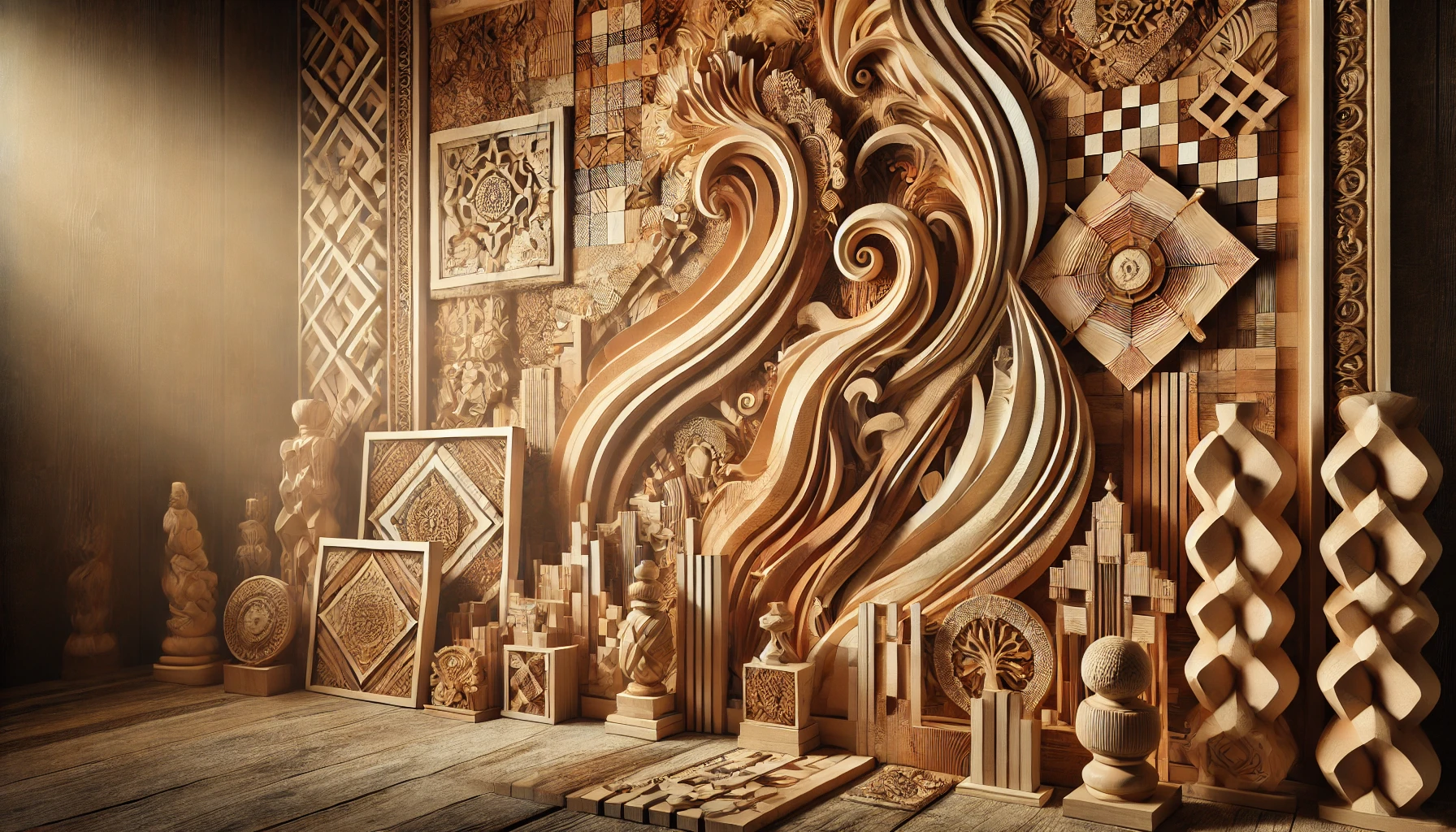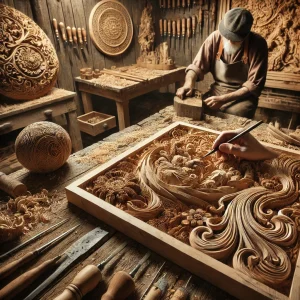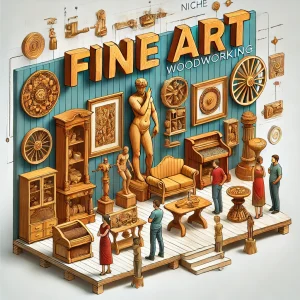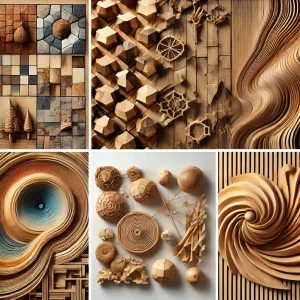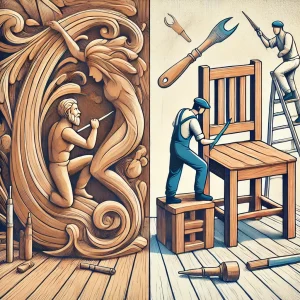What Is Wood Art?
For a long time, I was unaware of this particular area of woodworking. I couldn’t find it in any of the publications or on any of the popular woodworking websites. Even though they consistently add amazing new projects, tutorials, and reviews to their content. This might be the case because traditional woodworking, which places more of an emphasis on construction, is different from fine art woodworking.
Expression, embellishment, and, well, art are all part of wood art. It isn’t necessarily useful or intentional. Some work can be classified as either pure craft or pure art.
Throughout human history, wood has been a popular medium for crafts because of its inherent beauty, warmth, and adaptability. Wood crafts cover a broad spectrum of creations that highlight the talent, imagination, and workmanship of artists worldwide, ranging from useful items to elaborate works of art. We set out on a quest to comprehend the essence of wood crafts in this essay, delving into its varied shapes, rich history, and timeless appeal in our contemporary culture.
The technique of turning unfinished wood into useful and aesthetically pleasing items is known as wood crafts. There is proof that this ageless craft has deep roots in human history, as evidenced by wooden artifacts that date back thousands of years. Our material culture has been greatly influenced by wood, from prehistoric implements and utensils to elaborate carvings and architectural marvels.
Woodworking is an art form that encompasses both the process and the finished result. With their refined abilities and in-depth knowledge of the qualities of wood, artisans strive relentlessly to bring out its natural beauty and produce items that inspire feelings of awe and appreciation. Every work demonstrates their commitment, love, and skill at what they do.
Wood crafts include several different disciplines, such as joinery, marquetry, scrollwork, and furniture manufacturing, in addition to carving and woodturning. Marquetry, which is frequently found in elaborate boxes, furniture inlays, and decorative panels, is the process of creating complex patterns and motifs using veneers of various wood species. With its elaborate and delicate fretwork patterns, scrollwork exemplifies the deft use of wood to produce stunning ornamental pieces. To ensure the lifetime and structural integrity of furniture and architectural features, joinery, a fundamental aspect of carpentry, focuses on making solid and smooth connections between wood pieces. One of the most obvious and practical types of woodworking is furniture creation, which blends design and practicality to produce items that improve our living areas.
Wood crafts include several different disciplines, such as joinery, marquetry, scrollwork, and furniture manufacturing, in addition to carving and woodturning. Marquetry, which is frequently found in elaborate boxes, furniture inlays, and decorative panels, is the process of creating complex patterns and motifs using veneers of various wood species. With its elaborate and delicate fretwork patterns, scrollwork exemplifies the deft use of wood to produce stunning ornamental pieces. To ensure the lifetime and structural integrity of furniture and architectural features, joinery, a fundamental aspect of carpentry, focuses on making solid and smooth connections between wood pieces. One of the most obvious and practical types of woodworking is furniture creation, which blends design and practicality to produce items that improve our living areas.
Woodworking has left a lasting impression on our collective artistic legacy, spanning both time and cultural boundaries. Wood crafts have played a significant role in forming the beauty and atmosphere of our built environment, from the imposing temples of ancient civilizations to the elaborate wooden furnishings that adorn palaces and homes. When wood is handled by talented craftspeople, it can be used for cultural expression, storytelling, and the preservation of old crafts.
Origins of Wood Art
Most likely, wood art is nothing new. But for many years, only painters and sculptors could create beautiful art. Not even sculptors, actually. Only much later, thanks to the labor and dedication of skilled artisans, was sculpture admitted into the sacred realm of art.
However, artists and art forms that used media other than paint started to emerge and gain recognition in recent years. They were porters, ceramists, metalworkers, and glassblowers. Woodworking was no longer an anomaly. Additionally, wood art became recognized as such.
Difference between Wood ‘Art’ And Woodcraft
Creating wood art is a different approach to dealing with wood than using it for construction. A post we wrote a while back about the distinction between art and craft explains many of the differences. The history of the differentiation and the current state of affairs is fascinating and illuminating to read.
One of the concepts put up in that piece was that, despite the fact that artisanal abilities can be excellent, fine artists today earn significantly more money from their creations than craftspeople. There are explanations for this.
The stagnant nature of crafts in terms of originality and design is one of the causes of this salary gap. An artist is supposed to come up with new ideas and concepts with every project, but a craftsman rarely does.
In this way, art is viewed as a manifestation of the creator’s thoughts, emotions, expression, and message. An artisan would be regarded as a designer and, thus, an independent artist if he performed the same thing, that is, come up with fresh concepts and designs for his products. Nowadays, a lot of craftspeople do this.
Because the monetary worth must reflect the inherent value of the craft, including the raw materials and the expertise required to make it, a craftsman can only expect a particular amount for his labor.
The Functional Nature of Craft – Advantage & Disadvantage
An artisan must remember that his craft is functional. Any craft should have that as its identity. While the majority of fine art is decorative and aesthetically pleasing, all crafts are made to fulfill a purpose. It is intended to stimulate our senses and strike a chord with our emotions.
Fine art has a function in that regard as well. However, that goal is quite distinct from “functionality,” which implies that the object should be used existentially.
Crafts are true because they are functional. They are visually appealing when they are well-designed. However, it is precisely this functioning that denies them the distinction of being regarded as “art.”
Architecture, furniture, and other items that aren’t often regarded as “art” are frequently given the highest honor when they are called “works of art.”
Here, I want to emphasize the difference between creativity and art. Art is not the only medium for creativity. Everything from a pencil to an airplane is the result of creativity. Crafts and fine arts both require creativity. What separates the two is primarily their intent.
Now that we understand the distinction between art and craft, let’s examine the potential for fine art in woodworking.
Difference Between Wood Art And Other Alternative Craft Forms
I have mentioned artists blooming in all industries including metallurgy and pottery. However, wood art differs from even these in a way. Many pieces of wood art can have simple designs and be made with simple woodworking methods. It’s not as innovative as a glassblower doing the same thing or a potter throwing a unique shape.
As a result, the wood art’s apparent worth may occasionally be limited. Wood carving may seem like wood art to some of you. That isn’t always the case. The carvings are typically not unique, or even if they are, they are not a striking display of the carver’s inventiveness, even though carving requires a great deal of talent.
Because of this, wood carvings are typically limited to the realm of “craft” rather than evolving into artistic creations.
5 Contemporary Wood Art Styles You Need to See
The age-old and magnificent craft of carved wood art is undergoing a renaissance, and there has undoubtedly been a contemporary wood art Renaissance. Wood art is a very varied art form that balances romantic and rustic, ancient and distinctive. Our specialized research team has located and brought together the most skilled woodcrafters who are not only conserving this craft but also expanding its possibilities. These artists, who were chosen for their creativity, skill, aptitude, and refinement, are the pinnacle of wood art workmanship. You will see a wide variety of works in the following pieces that showcase the artistic possibilities of wood: from dynamic wood sculptures to oak feature walls, each item embodies a perfect blend of nature and humanity.
1. Wood Mosaic Tiles
Who said wood art had to be boring or static? We have found wood mosaic tiles, a type of woodcraft art that evokes air, movement, and even ocean ripples. This piece is particularly well-liked for giving an otherwise stuffy office setting a dash of refinement. With his skillful cutting and assembling of timber wood tiles into rippling surfaces, one of our artist wall artists is setting the standard for this style. His method is instinctive, with movement as its main element. Every block is naturally fashioned and carved by hand based on the material’s surface and grain. Through this technique, heavy blocks of wood are transformed into distinctive geometric wood art designs, moving from simple surfaces to a nuanced patchwork of browns, blacks, and off-whites—the natural world’s unadulterated, unaltered wood colors. This technique is timeless and inoffensive to almost any room, so it may be utilized for a timber feature wall or, more generally, to hang as 3D wall art anywhere you like. Please don’t hesitate to contact us if you need professional guidance on where to place this modern wood design so that we can suggest the best course of action for your idea.
2. Abstract Wood Sculpture
Abstract wood sculpture is as beautiful, but it works better as a featured piece because of its creative use of line, which gives the wood’s very center life. Wooden sculptures that appear to dance with the very soul of their nature are created by this artisan using his skillful carving and intuitive touch. The compelling use of relief, which produces a three-dimensional marvel that transcends traditional boundaries, is what distinguishes this wood craft art form. The sculptures’ wood relief carving patterns come to life as light and shadows play on their surface, creating fascinating patterns from these frequently geometric wood art designs that change and evolve according to the viewer’s changing perspective.
Site-specific work for hotel, residential, or public art projects is the specialty of another of our selected artists. Because of their distinctive and natural approach to abstract sculpture, his modern relief sculptures make excellent garden wood sculptures and are among the top wood craft trends of the year. By considering sustainable art materials and the effects of light and shadow on the wood craft artworks, he creates playful and nature-reflective patterns for his wooden sculptures that mix in with their surroundings.
3. Wood Feature Wall
Because they can basically become seamless extensions of their surrounding environs, wooden feature walls are becoming more and more popular. The natural beauty of the wood art design gives a calming element to any room, and celebrities have favored this option for their homes. Depending on the wood’s finish and design, wooden feature walls can bring a touch of rustic charm or contemporary attractiveness to the living rooms.
In contrast, these walls in the corporate world convey a great deal about the company’s culture and aesthetic. Whether in a traditional workspace or a modern office, carved wooden feature walls like the one created by this artist provide a sophisticated background that encourages productivity and creates a warm environment for both clients and staff.
In the hotel industry, wood sculpture’s warm and inviting textures are ideal for living rooms and bedrooms. They invite guests to enjoy the comforts of their surroundings and leave a lasting impression.
4. Sustainable Carved Wood Wall Art
For the minimalist art collector, these wood relief sculptures are a fitting addition to walls. A sensation of depth and dimension is created by the interaction of abstract shapes and natural textures, enticing spectators to examine the sculpted wood’s subtleties. Handmade wood art etched in unique wood relief carving patterns is being produced by carefully chosen carved wood artists and is growing in popularity in hotel areas.
These wooden sculptures serve as an easy reminder of the need to protect our world in addition to being aesthetically pleasing. The wood used in this art form symbolizes a deeper aim – to minimize the damage to our environment while enhancing the beauty it gives. He sources his wood from the nearby forest so that he may genuinely connect with his surroundings.
5. Kinetic Wood Sculpture
Last but not least, dynamic wood sculptures by David C. Roy are becoming more and more well-liked. The artist’s profound understanding of the harmonic harmony of shape and movement is evident in each piece. Roy creates geometric wood art marvels that captivate observers by skillfully fusing metal and wood with the accuracy of an engineer and the artistic touch of an artist. These dynamic wood sculptures evoke surprise and wonder in us as they come to life, simulating the intricate patterns of celestial orbits, the captivating beat of ocean waves, or the soft swing of leaves in the wind. Like all the wood artworks we have seen, but more acutely here, each piece skillfully captures the dance of nature, inspiring introspection and calm in those who view it.
Why Making Wood Art Is Good For Business and Profit
Why, then, should you think about creating and marketing beautiful art out of wood? Because artists typically earn more money than craftspeople, as we discussed a little while ago.
Yes, you can hire people to do big, expensive projects. However, large initiatives typically require a long-term commitment, a lot of overtime, and probably the recruitment of more staff. Unless you are managing a large-scale woodworking manufacturing facility, this presents its own set of problems.
Since this post is about the potential of woodworking art projects, let’s continue with that thought. When it comes to small projects, you want to choose things that you enjoy making, and that will earn you a good amount of money for each hour you invest in the building process. However, I should remind you that creating fine art woodworking projects is not the only way to do this; you can also increase profits by carefully using and planning business tactics, such as developing a brand image and finding other lucrative niches of woodcrafts.
1. Wood Art Projects Tend To Be High Profit
If you can sell your art, you can make money. Wood art also sells well. Wood art doesn’t always require a lot of resources. The concept and expression of any kind of art are what gives it its value. But as it stands, woodworking also involves the use of several instruments and unusual terms in the creative process. Even while the wood is always of high quality and frequently of an exotic variety, the equipment needed is typically not full-fledged construction tools.
2. Wood Art Projects Are Not labour Intensive
The quantity of man hours required is another factor contributing to the profitability of the wood art specialty. The piece of art requires a monetary value that is consistent with its artistic value and has little to do with the actual cost of manufacturing it. Additionally, it is typically a one-person endeavor, avoiding the need for additional labor in the end. It is instantly distinguished from the typical wood crafts by this very aspect.
Note: Here’s something I want to bring up. Compared to someone who does a decent craft, artists find it more difficult to sell in the first place, even though they stand to earn more money when successful. Because a craft is inherently useful and purposeful, it is simpler for an artisan to draw in customers. Therefore, the artist must remove some form of barrier to persuade people to spend a significant amount of money for the sake of appreciating art.
3. Fine Art Woodworking Is an Untapped Niche
A good niche is one in which there is a limited supply of the product and a select but highly interested consumer base. Woodworking art is a good fit.
4. Simple to brand and market
Fine art woodworking is easier to market since it occupies a unique niche. It is simpler to market something new to prospective customers and to create a brand around it. For the same reason, online advertising is inexpensive.
5. Most Wood Art Is Portable, Can Be Sold Online, and Shipped Easily
You want to use the Internet’s strength and potential to market your craft these days. Not everyone has a product that they can sell online, but anyone can advertise their business online.
Shipping is typically required when selling online. Even though anything may be delivered, including big furniture and shoes, having a lightweight, portable item makes shipping simpler, quicker, and less expensive. Even though wood is a very heavy medium, the completed artwork is typically small enough to be shipped across the nation at a fair price.
6. Sense of Freedom in Working For The Sake Of Art Expression
Although I have already discussed it in this essay, this is an intriguing point. Making crafts that serve a purpose and are useful is a rewarding experience. However, it is a freeing experience to create something out of pure imagination and expression without the limitations of practicality. You will have a whole different perspective on wood as a medium if you have never dealt with it before.
7. Art Can Be Used To Enhance Value of Existing Woodcrafts
You can utilize your designs to revitalize your current crafts after you see your ability and like creating wood art. You may never see the same wall shelf you have been building up to this point.
Conclusion
To sum up, wood crafts represent the harmonic fusion of the artisan’s creative energy with the natural raw material. Wood crafts have endured through the ages, enthralling us with their beauty, artistry, and adaptability in everything from historical carvings to contemporary sculptures, and useful furniture to ornamental accents. They demonstrate our ongoing passion for this extraordinary material by bridging the gap between tradition and innovation. The world of wood crafts offers an enthralling voyage into the domain of craftsmanship, tradition, and human ingenuity, regardless of whether you are a craftsman, an art aficionado, or just a lover of beauty.
That concludes my current opinions on wood art. Please share your thoughts in the space provided for comments below.

